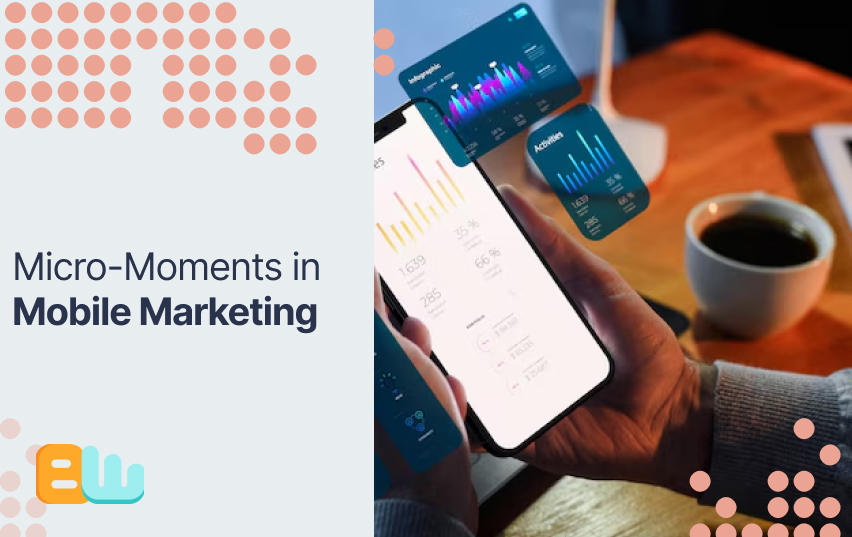
In a world where the average person checks their phone 96 times daily, mobile isn’t just another marketing channel—it’s where critical decisions happen. Welcome to the age of micro-moments, where consumer needs are met through fragmented digital interactions that last seconds but determine business success.
This guide will show you how to capture and transform these fleeting opportunities into decisive marketing wins.
The smartphone revolution hasn’t just changed how we communicate—it’s fundamentally transformed consumer behavior. Today’s buyers don’t follow linear journeys; they zigzag through dozens of digital touchpoints before making decisions.
Understanding the Power of Micro-Moments in Today’s Mobile World
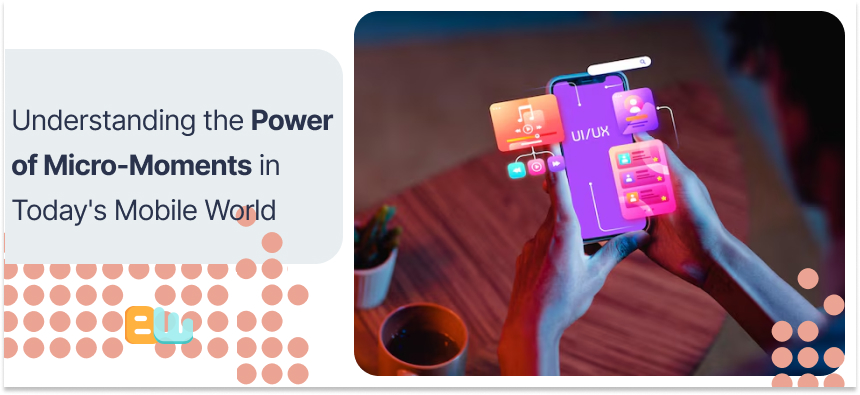
What Are Micro-Moments and Why They Matter for Marketers
Micro-moments are those split-second windows when consumers instinctively reach for their devices to learn, discover, watch, or purchase something. Google defines them as “intent-rich moments when decisions are made and preferences shaped.”
Why should you care? Because 96% of users reach for their smartphones when they need information. Each of these instances represents a critical opportunity to influence decisions.
Think about it: The average mobile session lasts just 70 seconds. In that brief window, your brand either makes an impression or gets forgotten.
The 4 Critical Types of Mobile Micro-Moments to Target
Not all micro-moments are created equal. Four specific types deserve your marketing attention:
1. I-want-to-know moments: When consumers research but aren’t ready to buy (e.g., “best running shoes for flat feet”)
2. I-want-to-go moments: When people search for local businesses or consider nearby purchases (“coffee shops near me”)
3. I-want-to-do moments: When someone wants to accomplish something (“how to tie a tie”)
4. I-want-to-buy moments: When someone is ready to make a purchase (“best deals on iPhone 13”)
Each moment type requires different content strategies, but all share one common need: immediate satisfaction.
How Consumer Behavior Has Evolved in the Mobile Era
Today’s mobile users exhibit three defining traits:
1. Impatience: 53% of mobile users abandon sites that take longer than 3 seconds to load.
2. Fractured attention: The average mobile session contains 6.5 website visits.
3. Expectation of personalization: 63% of smartphone users are likelier to purchase from companies whose mobile sites or apps offer personalized recommendations.
Your marketing must deliver instant value through snackable, personalized content that works flawlessly on small screens.
Capturing “I-Want-to-Know” Moments with Strategic Mobile Content
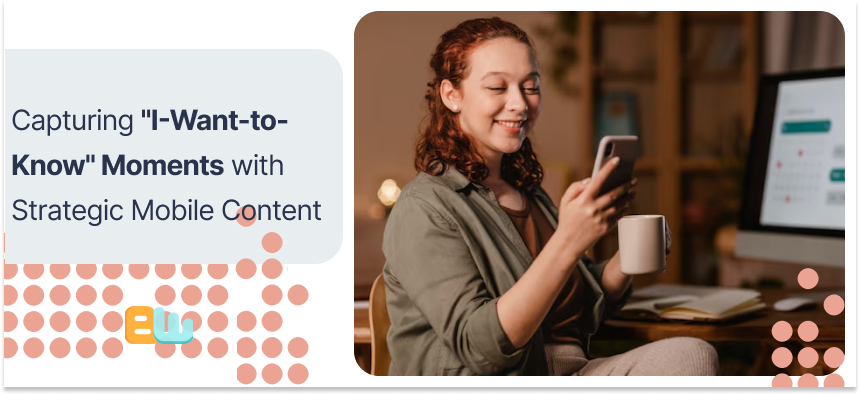
When consumers have questions, they expect instant answers. Your brand’s ability to provide those answers determines whether you are included in their consideration set.
Creating Informative Content That Answers Consumer Questions Quickly
For “I-want-to-know” moments, speed and clarity trump depth. Your content should:
• Get to the point in the first paragraph
• Use bullet points and numbered lists
• Include summaries for skimmers
• Incorporate visual aids that explain concepts quickly
For example, Sephora excels with its “Beauty Glossary,” which defines cosmetic terms in just 1-2 mobile-friendly sentences, with tap-to-expand options for those wanting more.
Remember that 41% of these information searches eventually lead to a purchase. Your goal isn’t immediate conversion but positioning your brand as a helpful authority.
5 Ways to Optimize Your Mobile Search Visibility
To be found during information-seeking micro-moments:
1. Target question-based keywords: Focus on phrases starting with who, what, when, where, why, and how.
2. Create FAQ content: Build pages specifically addressing common industry questions.
3. Optimize for featured snippets: Structure content with straightforward questions and concise answers to win Google’s position zero.
4. Leverage schema markup: Implement FAQ and How-To schema to enhance your SERP appearance.
5. Keep load times under 2 seconds: Use Google’s PageSpeed Insights to identify mobile speed issues.
American Express does this brilliantly by creating snackable financial explainers that appear in featured snippets for common money questions.
Leveraging Data to Anticipate Customer Information Needs
Don’t wait for questions—anticipate them by:
• Analyzing your site’s search data to identify information gaps
• Monitoring Google Trends to spot rising questions in your industry
• Examining competitor content for unanswered questions
• Using tools like Answer the Public to discover question clusters
REI exemplifies this approach with its seasonal gear guides, which anticipate and answer questions before customers search for them.
Turning “I-Want-to-Go” Moments into Local Business Opportunities
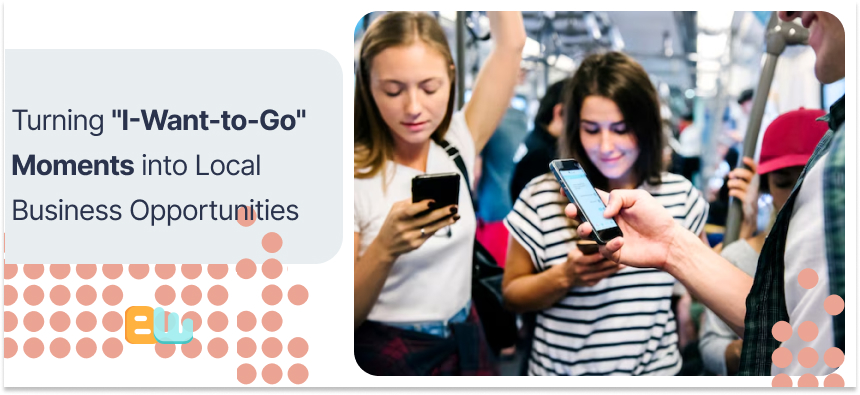
When mobile searches include “near me,” purchase intent is sky-high. These location-based micro-moments directly influence 76% of in-store visits.
Location-Based Marketing Strategies That Drive Foot Traffic
To capture these moments:
• Implement geo-targeted mobile ads that activate within specific radiuses
• Create location-specific landing pages with unique offers
• Use mobile push notifications when customers enter your area
• Design mobile-specific promotions that drive in-store traffic
Starbucks masters this with its app’s location-aware functionality, which lets users order ahead at the nearest location with just two taps.
How to Optimize Your Mobile Presence for Local Searches
Local visibility requires:
• A fully-claimed and optimized Google Business Profile
• Location-specific keywords in titles and meta descriptions
• Mobile-friendly store locator functionality
• Local schema markup implementation
• Consistent NAP (name, address, phone) information across the web
Home Depot excels with store-specific inventory information that tells mobile searchers exactly which nearby location has the item they need.
Measuring the Impact of Mobile on In-Store Visits
Track the offline impact of mobile moments by:
• Using Google Store Visits tracking in Google Ads
• Implementing coupon codes specific to mobile campaigns
• Creating dedicated landing pages for in-store offers
• Using “how did you hear about us” data at point of sale
• Measuring foot traffic increases during mobile campaign periods
Target’s success with this approach is evident in the 20% increase in store visits directly attributed to mobile search campaigns.
Maximizing “I-Want-to-Do” Moments with Actionable Mobile Resources
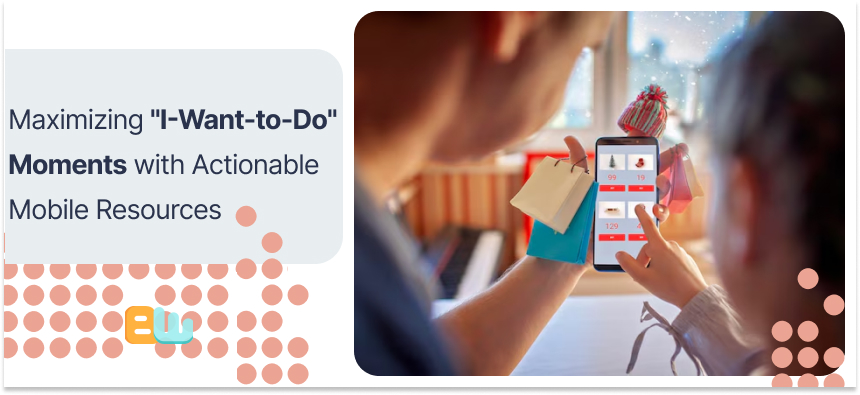
The “how to” search is among the fastest-growing mobile queries, with 91% of smartphone users turning to their devices for step-by-step guidance.
Creating Tutorial Content That Shines on Mobile Devices
Practical mobile tutorials should:
• Break processes into clearly numbered steps
• Use visual aids for each step
• Include short-form video options
• Offer printable/saveable instructions
• Feature a progress indicator for multi-step processes
IKEA’s mobile assembly instructions exemplify this approach with tap-through steps that users can follow at their own pace.
7 Examples of Brands Excelling at How-To Mobile Marketing
1. Home Depot’s DIY project videos: Optimized for vertical viewing with text overlays
2. Tasty’s recipe GIFs: Compressed, looping visual instructions perfect for small screens
3. Sephora’s makeup tutorials: Featuring 60-second versions for quick mobile consumption
4. Lowe’s “Fix in Six” Vine series: Ultra-short home improvement tips
5. L’Oréal’s Style My Hair app: AR tool showing hair color results before purchasing
6. Nike Training Club app: Workout instructions that adapt to available screen space
7. IKEA Place app: AR tool showing exactly how furniture fits in your space
Why Video Dominates the Mobile “I-Want-to-Do” Landscape
Video instructions rule mobile because:
• 65% of people are visual learners
• Video completion rates on mobile exceed desktop by 35%
• Users retain 95% of a message when watching video versus 10% when reading
• 6 out of 10 YouTube users report the platform helps them accomplish tasks
The key is keeping instructional videos under 60 seconds when possible and ensuring they work well without sound.
Converting “I-Want-to-Buy” Moments into Mobile Sales
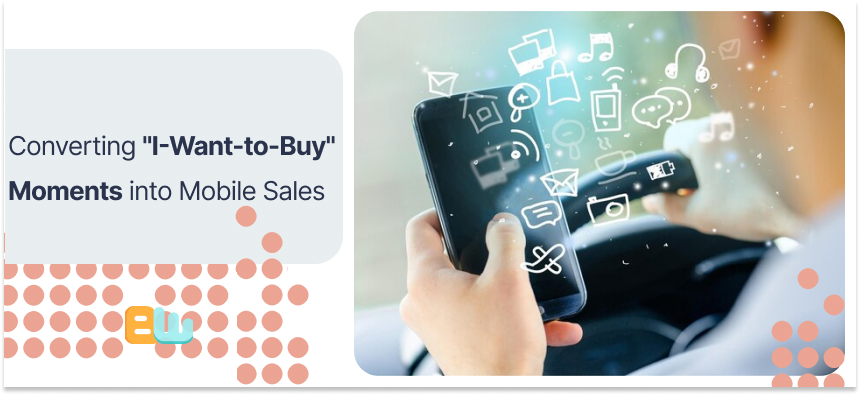
Purchase-ready micro-moments yield the highest conversion potential, yet 84% of consumers report experiencing difficulty completing mobile transactions.
Reducing Friction in the Mobile Purchase Journey
To smooth the path to purchase:
• Implement one-tap checkout options
• Reduce form fields to the essential minimum
• Offer guest checkout options
• Save user information for repeat purchases
• Design thumb-friendly button placement
Amazon’s “Buy Now” button represents the gold standard, reducing the purchase process to a single tap for returning customers.
Effective Mobile Call-to-Action Strategies That Boost Conversions
Mobile CTAs should:
• Use action-oriented language (“Get,” “Try,” “Start”)
• Create urgency without being pushy
• Contrast visually with surrounding elements
• Appear above the fold
• Be at least 44×44 pixels (Apple’s recommended minimum tap target)
Booking.com exemplifies this with their “Book Now, Pay Later” buttons that combine urgency with risk reduction.
How to Use Mobile Payment Solutions to Capture Impulse Buys
Leverage mobile wallets to reduce purchase barriers:
• Integrate Apple Pay, Google Pay, and Samsung Pay
• Highlight security features to build trust
• Display mobile payment options early in the shopping process
• Create mobile-exclusive flash sales
• Implement one-click reordering for consumable products
Starbucks drives 40% of their U.S. sales through mobile payments, making the process faster than cash.
Measuring and Optimizing Your Micro-Moment Marketing Strategy
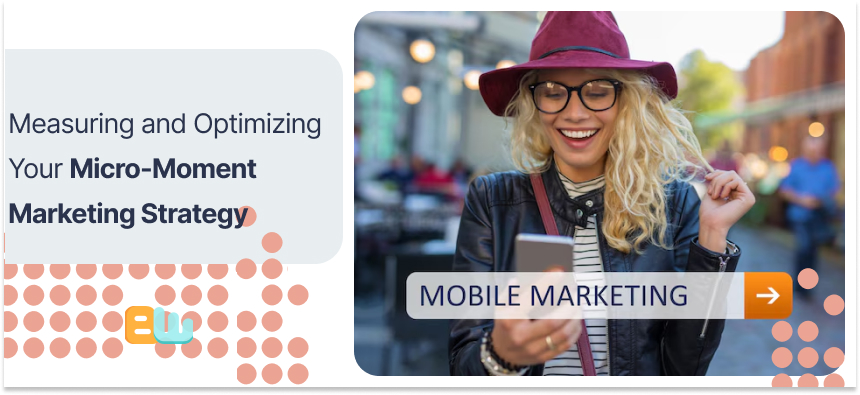
Without proper measurement, micro-moment marketing becomes guesswork.
Essential KPIs for Tracking Micro-Moment Campaign Success
For each moment type, track different metrics:
I-want-to-know moments:
• Content engagement time
• Return visitor rate
• Pages per session
• Newsletter signups
I-want-to-go moments:
• Local search impression share
• Store locator usage
• “Get directions” clicks
• Local conversion rate
I-want-to-do moments:
• Video completion rate
• Time on instructional pages
• Tutorial shares
• User-generated content creation
I-want-to-buy moments:
• Mobile conversion rate
• Cart abandonment rate
• Average order value
• Mobile payment adoption
A/B Testing Approaches for Improving Mobile Engagement
Test these elements to optimize micro-moment performance:
• Headline variations for search snippets
• Different video lengths for tutorials
• Various CTA placements and wording
• Mobile form designs
• Page load optimizations
Expedia found that removing just one unnecessary field from their mobile booking form increased conversions by $12 million annually.
Creating a Cross-Channel Attribution Model for Micro-Moments
Since micro-moments rarely exist in isolation:
• Implement cross-device tracking
• Use view-through attribution
• Assign weighted values to different moment types
• Measure time-to-conversion by entry point
• Track the influence of upper-funnel moments on purchases
Google’s study with Bain & Company found that customers who engage with a brand across multiple micro-moments are 40% more likely to convert.
Future Trends in Micro-Moment Mobile Marketing
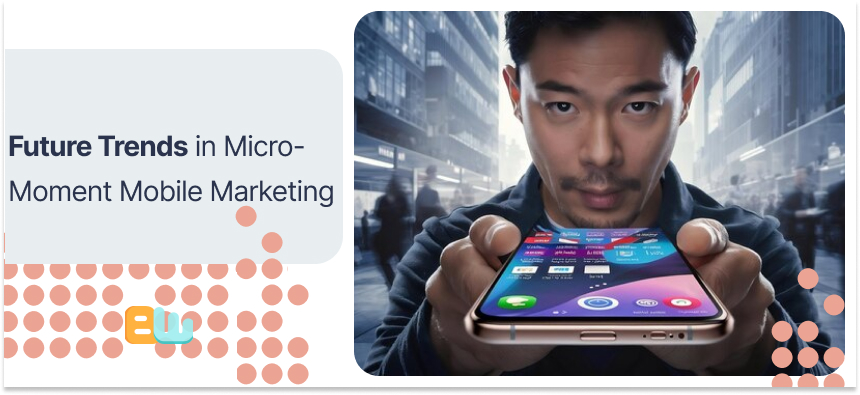
The micro-moment landscape continues evolving with new technologies.
How Voice Search is Changing the Micro-Moment Landscape
Voice-initiated searches now constitute 20% of all mobile searches, changing micro-moment strategy:
• Optimize for conversational keywords (average voice search contains 7+ words)
• Create content that directly answers specific questions
• Focus on featured snippet optimization
• Design actions for voice assistants
• Consider the context of voice searches (often hands-free situations)
Domino’s Pizza leverages this with their zero-click ordering, letting customers reorder their favorite pizza by voice alone.
Leveraging AI and Predictive Analytics for Anticipating Moments
The future belongs to brands that can predict micro-moments before they happen:
• Use machine learning to identify patterns in customer behavior
• Implement predictive product recommendations
• Create triggered content based on behavioral signals
• Develop proactive notifications for likely needs
• Build smart retargeting based on micro-moment intent signals
Netflix exemplifies this approach by predicting which content will interest viewers before they even search for it.
What 5G Technology Means for the Evolution of Micro-Moments
As 5G becomes ubiquitous, micro-moment marketing will transform through:
• Instant-loading experiences (sub-1-second)
• Rich AR experiences delivered on-demand
• High-definition mobile video without buffering
• Location-based experiences with centimeter-level precision
• Edge computing enabling real-time personalization
Forward-thinking brands like Walmart are already preparing with AR shopping experiences that will become standard in the 5G era.
—
The brands that win in the mobile era will not be those with the biggest budgets but those who best understand and serve micro-moments. By meeting customers with exactly what they need when they need it, you create not just conversions but lasting loyalty.
Remember: Every glance at a smartphone screen represents an opportunity. Make each moment count.
#micromoments #mobilemarketing
